Services We Provide
-
Teeth Cleaning and Polishing
Teeth Cleaning and Polishing
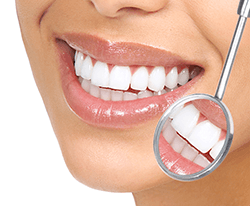 The ADA recommends the following for good oral hygiene:
The ADA recommends the following for good oral hygiene:- Brush your teeth twice a day with a fluoride toothpaste. Replace your toothbrush every three or four months or sooner if the bristles are frayed.
- Clean between teeth daily with floss. Decay–causing bacteria still linger between teeth where toothbrush bristles can’t reach. This helps remove plaque and food particles from between the teeth and under the gum line.
- Eat a balanced diet and limit between-meal snacks.
-
Invisalign
Invisalign
 Breakthrough technology that lets you have the smile you've always wanted — without the hassle of braces.
Breakthrough technology that lets you have the smile you've always wanted — without the hassle of braces.
The clear alternative to metal braces. By using a series of clear, removable aligners, Invisalign straightens your teeth with results you'll notice sooner than you think. The course of treatment involves changing aligners approximately every two weeks, moving your teeth into straighter position step by step, until you have a more beautiful smile. And unlike braces, these clear aligners can be removed while you eat and brush your teeth as usual.
Less treatment time. An average Invisalign course of treatment takes about a year. You'll see your Invisalign Certified Dentist every 6 to 8 weeks for adjustments and to check progress. At regular intervals, you'll receive a new set of custom-molded clear aligners to continue the straightening process. The total number of clear aligners is specific to you, determined by your doctor for your course of treatment.
Clear and comfortable. Since Invisalign is practically invisible, there's no unwarranted attention to your mouth. In fact, very few people will notice at all—unless you tell them. They're comfortable to wear and remove easily when you eat, brush, and floss.
Get that gorgeous smile you’ve always wanted. For more information visit www.invisalign.com or give us a call. We’d be happy to sit down with you and show you how Invisalign can improve your smile. -
In Office Whitening
In Office Whitening
 You may want to start by speaking with us. We can tell you whether whitening procedures would be effective for you. If you are a candidate for bleaching, we may suggest a procedure that can be done in our office. This procedure is called chairside bleaching and may require more than one office visit. Each visit may take from 30 minutes to one hour. During chairside bleaching, we will apply either a protective gel to your gums or a rubber shield to protect the oral soft tissues. A bleaching agent is then applied to the teeth, and a special light may be used to enhance the action of the agent.
You may want to start by speaking with us. We can tell you whether whitening procedures would be effective for you. If you are a candidate for bleaching, we may suggest a procedure that can be done in our office. This procedure is called chairside bleaching and may require more than one office visit. Each visit may take from 30 minutes to one hour. During chairside bleaching, we will apply either a protective gel to your gums or a rubber shield to protect the oral soft tissues. A bleaching agent is then applied to the teeth, and a special light may be used to enhance the action of the agent. -
Restorations: Fillings, Onlays, Crowns, Veneers
Restorations: Fillings, Onlays, Crowns, Veneers
 Thanks to advances in modern dental materials and techniques, dentists have more ways to create pleasing, natural-looking smiles. Dental researchers are continuing their often decades-long work developing materials, such as ceramics and polymer compounds that look more like natural teeth. As a result, today we have several choices when it comes to selecting materials to repair missing, worn, damaged or decayed teeth.
Thanks to advances in modern dental materials and techniques, dentists have more ways to create pleasing, natural-looking smiles. Dental researchers are continuing their often decades-long work developing materials, such as ceramics and polymer compounds that look more like natural teeth. As a result, today we have several choices when it comes to selecting materials to repair missing, worn, damaged or decayed teeth.
If you want a smile that's your crowning glory, you may need a crown to cover a tooth and restore it to its normal shape and size. A crown can make your tooth stronger and improve its appearance.
It can cover and support a tooth with a large filling when there isn't enough tooth left. It can be used to attach a bridge, protect a weak tooth from breaking or restore one that's already broken. A crown is a good way to cover teeth that are discolored or badly shaped. It's also used to cover a dental implant. -
Fixed Bridges
Fixed Bridges
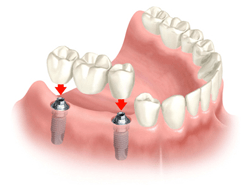 Designed to replace missing teeth, a fixed bridge is used in conjunction with adjacent teeth and/or implants to support natural looking teeth that rest in open spaces. A fixed bridge can replace as few as one missing tooth or as many as ten.
Designed to replace missing teeth, a fixed bridge is used in conjunction with adjacent teeth and/or implants to support natural looking teeth that rest in open spaces. A fixed bridge can replace as few as one missing tooth or as many as ten. -
Root Canal Treatment
Root Canal Treatment
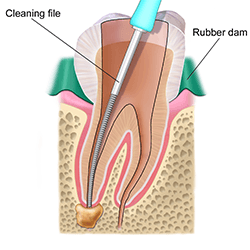 Once upon a time, if you had a tooth with a diseased nerve, you'd probably lose that tooth. Today, with a special dental procedure called a root canal therapy you may save that tooth. Inside each tooth is the pulp which provides nutrients and nerves to the tooth, it runs like a thread down through the root. When the pulp is diseased or injured, the pulp tissue dies. If you don't remove it, your tooth gets infected and you could lose it. After the dentist removes the pulp, the root canal is cleaned and sealed off to protect it. Then your dentist places a crown over the tooth to help make it stronger.
Once upon a time, if you had a tooth with a diseased nerve, you'd probably lose that tooth. Today, with a special dental procedure called a root canal therapy you may save that tooth. Inside each tooth is the pulp which provides nutrients and nerves to the tooth, it runs like a thread down through the root. When the pulp is diseased or injured, the pulp tissue dies. If you don't remove it, your tooth gets infected and you could lose it. After the dentist removes the pulp, the root canal is cleaned and sealed off to protect it. Then your dentist places a crown over the tooth to help make it stronger.
Your restored tooth could last a lifetime, if you continue to care for your teeth and gums. However, regular checkups are necessary. As long as the root(s) of a treated tooth are nourished by the tissues around it, your tooth will remain healthy. Most of the time, a root canal is a relatively simple procedure with little or no discomfort involving one to three visits. Best of all, it can save your tooth and your smile! -
Removable Partial and Full Dentures
Removable Partial and Full Dentures
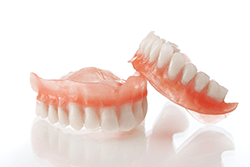 Removable partial dentures usually consist of replacement teeth attached to pink or gum-colored plastic bases, which are connected by metal framework. Removable partial dentures attach to your natural teeth with metal clasps or devices called precision attachments. Precision attachments are generally more esthetic than metal clasps and they are nearly invisible. Crowns on your natural teeth may improve the fit of a removable partial denture and they are usually required with attachments.
Removable partial dentures usually consist of replacement teeth attached to pink or gum-colored plastic bases, which are connected by metal framework. Removable partial dentures attach to your natural teeth with metal clasps or devices called precision attachments. Precision attachments are generally more esthetic than metal clasps and they are nearly invisible. Crowns on your natural teeth may improve the fit of a removable partial denture and they are usually required with attachments.
There are various types of complete dentures. A conventional full denture is made and placed in the patient’s mouth after the remaining teeth are removed and tissues have healed which may take several months. An immediate complete denture is inserted as soon as the remaining teeth are removed. The dentist takes measurements and makes models of the patient’s jaws during a preliminary visit. With immediate dentures, the denture wearer does not have to be without teeth during the healing period.
Even if you wear full dentures, you still must take good care of your mouth. Brush your gums, tongue and palate every morning with a soft-bristled brush before you insert your dentures to stimulate circulation in your tissues and help remove plaque. You also need to see your dentist to check the tissues and the denture fit. -
Treatment of Gum Disease
Treatment of Gum Disease
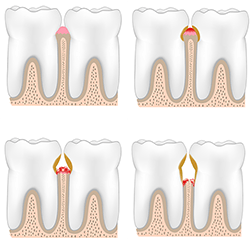 Periodontal disease is an infection of the tissues that support your teeth. Your gum tissue is not attached to the teeth as high as it may seem. There is a very shallow v-shaped crevice called a sulcus between the tooth and gums. Periodontal diseases attack just below the gum line in the sulcus, where they cause the attachment of the tooth and its supporting tissues to break down. As the tissues are damaged, the sulcus develops into a pocket: generally, the more severe the disease, the greater the depth of the pocket.
Periodontal disease is an infection of the tissues that support your teeth. Your gum tissue is not attached to the teeth as high as it may seem. There is a very shallow v-shaped crevice called a sulcus between the tooth and gums. Periodontal diseases attack just below the gum line in the sulcus, where they cause the attachment of the tooth and its supporting tissues to break down. As the tissues are damaged, the sulcus develops into a pocket: generally, the more severe the disease, the greater the depth of the pocket.
Periodontal diseases are classified according to the severity of the disease. The two major stages are gingivitis and periodontitis. Gingivitis is a milder and reversible form of periodontal disease that only affects the gums. Gingivitis may lead to more serious, destructive forms of periodontal disease called periodontitis.
Some factors increase the risk of developing periodontal disease:- Tobacco smoking or chewing
- Systemic diseases such as diabetes
- Some types of medication such as steroids, some types of anti-epilepsy drugs, cancer therapy drugs, some calcium channel blockers and oral contraceptives
- Bridges that no longer fit properly
- Crooked teeth
- Fillings that have become defective
- Pregnancy or use of oral contraceptives
- Gums that bleed easily.
- Red, swollen, tender gums.
- Gums that have pulled away from the teeth.
- Persistent bad breath or bad taste.
- Permanent teeth that are loose or separating.
- Any change in the way your teeth fit together when you bite.
- Any change in the fit of partial dentures.
-
Implants
Implants
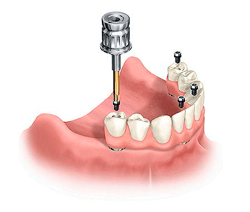 Crowns and conventional bridges or dentures may not be your only options when replacing missing teeth. For some people, dental implants offer a smile that looks and feels very natural. Surgically placed below the gums over a series of appointments, implants fuse to the jawbone and serve as a base for individual replacement teeth, bridges or a denture.
Crowns and conventional bridges or dentures may not be your only options when replacing missing teeth. For some people, dental implants offer a smile that looks and feels very natural. Surgically placed below the gums over a series of appointments, implants fuse to the jawbone and serve as a base for individual replacement teeth, bridges or a denture.
Implants offer stability because they fuse to your bone. Integration of the implants into your jaw also helps your replacement teeth feel more natural and some people also find the secure fit more comfortable than conventional substitutes.
Candidates for dental implants need to have healthy gums and adequate bone to support the implant. A thorough evaluation by your dentist will help determine whether you are a good candidate for dental implants. -
Tooth Extraction
Tooth Extraction
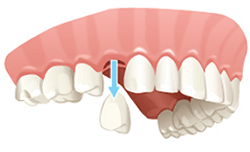 What should you expect when you are scheduled for a tooth extraction?
What should you expect when you are scheduled for a tooth extraction?
We will numb the area to lessen any discomfort. After the extraction, we will advise you of what post extraction regimen to follow, in most cases a small amount of bleeding is normal.
Avoid anything that might prevent normal healing. It is usually best not to smoke or rinse your mouth vigorously, or drink through a straw for 24 hours. These activities could dislodge the clot and delay healing. For the first few days, if you must rinse, rinse your mouth gently afterward, for pain or swelling, apply a cold cloth or an ice bag. When having an extraction, today's modern procedures and follow up care are there to provide you the patient great benefit and comfort. -
Oral Cancer Screening
Oral Cancer Screening
We have recent good news about progress against cancer. It is now easier than ever to detect oral cancer early, when the opportunity for a cure is great. Currently only half of all patients diagnosed with oral cancer survive more than five years. We have the skills and tools to ensure that early signs of cancer and pre-cancerous conditions are identified. You and your dentist can fight and win the battle against oral cancer. Know the early signs and see your dentist regularly.- Oral Cancer often starts as a tiny, unnoticed white or red spot or sore anywhere in the mouth.
- It can affect any area of the oral cavity including the lips, gum tissue, cheek lining, tongue and the hard or soft palate.
-
Bite Splints and Mouth Guards
Bite Splints and Mouth Guards
 What Is Bruxism?
What Is Bruxism?
"Keep a stiff upper lip" or "get a grip!" That's often the advice we get—and give—on how to cope with stress. If you take it literally, the result could be grinding your teeth or clenching your jaws. It's called bruxism, and often it happens as we sleep, caused not just by stress and anxiety but by sleep disorders, an abnormal bite or teeth that are missing or crooked.
Symptoms include a dull headache or a sore jaw. You could have teeth that are painful or loose from severe grinding. This can lead to fractures in your teeth.
We can fit you with a mouth guard to protect your teeth during sleep.
If stress is the cause you need to find a way to relax! Physical therapy, muscle relaxants, counseling and even exercise may help reduce tension.
Don't make your teeth the brunt of your stress
Mouthguards
Use a mouthguard during any activity that could result in a blow to the face or mouth. A properly fitted mouthguard can help prevent broken teeth and injuries to the lips, tongue, face or jaw. It will stay in place while you are wearing it, making it easy for you to talk and breath. Talk to us about having a custom mouthguard made specifically for you. This will fit comfortably and offer the best protection for your smile. -
Bad Breath Treatment
Bad Breath Treatment
Whether you call it bad breath or halitosis, it’s an unpleasant condition that’s cause for embarrassment. Some people with bad breath aren’t even aware there’s a problem. If you’re concerned about bad breath, see us. We can help identify the cause and, if it’s due to an oral condition, develop a treatment plan to help eliminate it. -
Digital X-Ray
Digital X-Ray
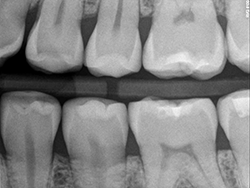 Digital x-rays are quickly becoming the standard in dental imaging.
Digital x-rays are quickly becoming the standard in dental imaging.
Digital x-rays allow the doctor to get a much better view of your teeth and potential dental conditions. The digital imaging software allows the doctor to see a number of different views of the tooth to gain a better understanding of the proper course of management. Digital x-rays provide a great benefit to the patient. Not only are they an excellent diagnostic tool, but they decrease radiation to the patient by over 80%.

